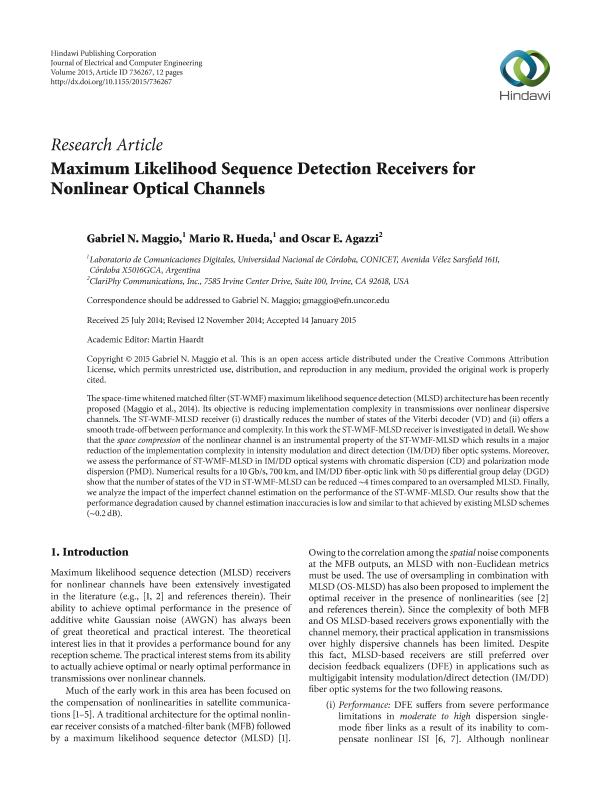Mostrar el registro sencillo del ítem
dc.contributor.author
Maggio, Gabriel Nicolás

dc.contributor.author
Hueda, Mario Rafael

dc.contributor.author
Agazzi, Oscar Ernesto

dc.date.available
2018-05-29T19:56:11Z
dc.date.issued
2015-03
dc.identifier.citation
Maggio, Gabriel Nicolás; Hueda, Mario Rafael; Agazzi, Oscar Ernesto; Maximum Likelihood Sequence Detection Receivers for Nonlinear Optical Channels; Hindawi Publishing Corporation; Journal of Electrical and Computer Engineering; 2015; 736267; 3-2015; 1-12
dc.identifier.issn
2090-0155
dc.identifier.uri
http://hdl.handle.net/11336/46501
dc.description.abstract
The space-time whitened matched filter (ST-WMF) maximum likelihood sequence detection (MLSD) architecture has been recently proposed (Maggio et al., 2014). Its objective is reducing implementation complexity in transmissions over nonlinear dispersive channels. The ST-WMF-MLSD receiver (i) drastically reduces the number of states of the Viterbi decoder (VD) and (ii) offers a smooth trade-off between performance and complexity. In this work the ST-WMF-MLSD receiver is investigated in detail. We show that the space compression of the nonlinear channel is an instrumental property of the ST-WMF-MLSD which results in a major reduction of the implementation complexity in intensity modulation and direct detection (IM/DD) fiber optic systems. Moreover, we assess the performance of ST-WMF-MLSD in IM/DD optical systems with chromatic dispersion (CD) and polarization mode dispersion (PMD). Numerical results for a 10 Gb/s, 700 km, and IM/DD fiber-optic link with 50 ps differential group delay (DGD) show that the number of states of the VD in ST-WMF-MLSD can be reduced ~4 times compared to an oversampled MLSD. Finally, we analyze the impact of the imperfect channel estimation on the performance of the ST-WMF-MLSD. Our results show that the performance degradation caused by channel estimation inaccuracies is low and similar to that achieved by existing MLSD schemes (~0.2 dB).
dc.format
application/pdf
dc.language.iso
eng
dc.publisher
Hindawi Publishing Corporation

dc.rights
info:eu-repo/semantics/openAccess
dc.rights.uri
https://creativecommons.org/licenses/by/2.5/ar/
dc.subject
St-Wmf
dc.subject
Mlsd
dc.subject
St-Wmf-Mlsd Receiver
dc.subject
Im/Dd
dc.subject
Chromatic Dispersion
dc.subject.classification
Ingeniería de Sistemas y Comunicaciones

dc.subject.classification
Ingeniería Eléctrica, Ingeniería Electrónica e Ingeniería de la Información

dc.subject.classification
INGENIERÍAS Y TECNOLOGÍAS

dc.title
Maximum Likelihood Sequence Detection Receivers for Nonlinear Optical Channels
dc.type
info:eu-repo/semantics/article
dc.type
info:ar-repo/semantics/artículo
dc.type
info:eu-repo/semantics/publishedVersion
dc.date.updated
2018-05-09T14:09:24Z
dc.journal.volume
2015
dc.journal.number
736267
dc.journal.pagination
1-12
dc.journal.pais
Estados Unidos

dc.journal.ciudad
Nueva York
dc.description.fil
Fil: Maggio, Gabriel Nicolás. Universidad Nacional de Córdoba. Facultad de Cs.exactas Físicas y Naturales. Departamento de Electronica. Laboratorio de Comunicaciones; Argentina. Consejo Nacional de Investigaciones Científicas y Técnicas; Argentina
dc.description.fil
Fil: Hueda, Mario Rafael. Universidad Nacional de Córdoba. Facultad de Cs.exactas Físicas y Naturales. Departamento de Electronica. Laboratorio de Comunicaciones; Argentina. Consejo Nacional de Investigaciones Científicas y Técnicas; Argentina
dc.description.fil
Fil: Agazzi, Oscar Ernesto. ClariPhy Communications; Estados Unidos
dc.journal.title
Journal of Electrical and Computer Engineering
dc.relation.alternativeid
info:eu-repo/semantics/altIdentifier/doi/http://dx.doi.org/10.1155/2015/736267
dc.relation.alternativeid
info:eu-repo/semantics/altIdentifier/url/https://www.hindawi.com/journals/jece/2015/736267/
Archivos asociados
